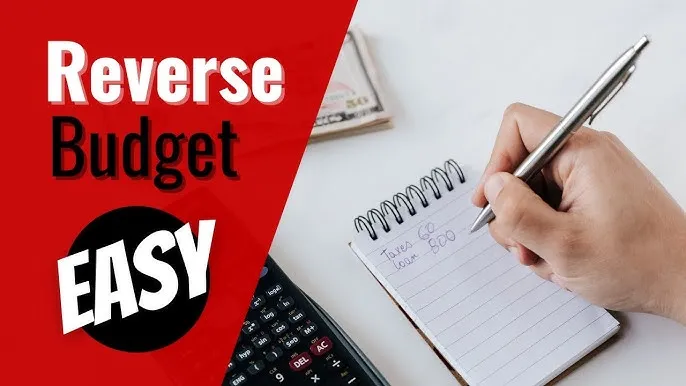Are you looking for a budgeting method that simplifies saving while ensuring your essential expenses are covered? Reverse Budgeting may be the perfect solution. In a traditional budget, you start with your income, subtract expenses, and save whatever remains. But with Reverse Budgeting, the priority is reversed—you pay yourself first by saving a predetermined amount, then allocate what’s left for expenses. This “pay yourself first” approach promotes disciplined saving and a healthier savings plan.
In this guide, we’ll explore what Reverse Budgeting entails, its benefits, and the five steps to implement it for long-term financial success.
What is Reverse Budgeting?
Reverse Budgeting is a financial strategy that flips the traditional budgeting process. Instead of saving what’s left after expenses, you decide how much to save upfront and adjust your spending around that goal. By prioritizing your savings, Reverse Budgeting promotes financial growth, security, and a consistent habit of investing in your future.
Why Choose Reverse Budgeting?
Reverse budgeting offers several unique advantages over traditional budgeting:
- Guaranteed Savings: Since you save first, you’re less likely to skip or delay saving.
- Reduced Financial Stress: By paying yourself first, you prioritize financial health and avoid overextending.
- Improved Spending Habits: It encourages mindful spending because your expenses must fit around your savings goal.
5 Steps to Start Reverse Budgeting and Pay Yourself First
Implementing Reverse Budgeting may sound challenging, but by following these five steps, you can easily incorporate it into your financial routine and begin to pay yourself first for a healthier savings plan.
Step 1: Determine Your Savings Goals
Start by deciding on a monthly savings goal. This amount should reflect your financial priorities, such as building an emergency fund, saving for retirement, or investing in personal development.
- Set Clear Goals: Whether you’re saving for a short-term vacation or a long-term retirement fund, be specific about your goals.
- Use SMART Criteria: Make sure your goals are Specific, Measurable, Achievable, Relevant, and Time-bound to stay on track.
Step 2: Automate Your Savings
One of the easiest ways to succeed with Reverse Budgeting is to automate the process. Set up automatic transfers to move your designated savings amount from your paycheck to a separate savings account.
- Direct Deposit Options: Many employers allow you to split your paycheck into multiple accounts, making it simple to pay yourself first.
- Use Financial Apps: Apps like Mint or YNAB can help automate transfers and track progress.
Step 3: Budget for Essential Expenses
With Reverse Budgeting, once you’ve set aside your savings, the remaining amount is for necessary expenses, including rent, utilities, groceries, and transportation.
- Identify Essential Expenses: Create a list of unavoidable monthly expenses.
- Adjust Your Spending Habits: If your income doesn’t cover all your expenses after saving, look for areas where you can cut back, such as dining out or subscriptions.
Step 4: Allocate Funds for Discretionary Spending
After essential expenses, you’ll allocate the remaining funds toward discretionary spending. This category includes entertainment, hobbies, and non-essential items.
- Set Limits for Extras: Decide in advance how much you’re willing to spend on non-essentials.
- Track Discretionary Spending: Keeping a record can help you maintain balance and avoid overspending.
Step 5: Regularly Review and Adjust Your Budget
Your financial situation and priorities will change over time, so regularly reviewing your Reverse Budgeting strategy is essential.
- Review Monthly: At the end of each month, evaluate your budget and savings.
- Adjust as Needed: If your income or expenses change, update your savings goal or spending limits to reflect your current needs.
Benefits of Reverse Budgeting for a Healthier Financial Future
Practicing Reverse Budgeting offers numerous benefits, such as achieving financial security and developing disciplined spending habits.
- Enhanced Savings Growth: By consistently saving first, your savings will accumulate faster.
- Peace of Mind: Knowing that your savings are handled first reduces financial stress and gives you a sense of control.
- Improved Financial Planning: Reverse budgeting fosters better financial planning, helping you prioritize both present and future needs.
Common Challenges and How to Overcome Them
While Reverse Budgeting is highly effective, it may present challenges, especially if your income fluctuates. Here are some tips to stay on track:
- For Irregular Income: When income varies, save a set percentage rather than a fixed amount.
- Unexpected Expenses: Build an emergency fund to handle unforeseen expenses without disrupting your budget.
- Staying Consistent: Automation can simplify reverse budgeting and ensure that you consistently save first.
Who Should Use Reverse Budgeting?
Reverse Budgeting is ideal for individuals who:
- Struggle with Traditional Budgeting: If you find it challenging to save after covering expenses, Reverse Budgeting can provide a new approach.
- Seek Long-Term Savings Growth: Those who want to prioritize savings goals over short-term spending can benefit.
- Desire Financial Discipline: Reverse budgeting encourages mindful spending and reduces financial stress.
Reverse Budgeting vs. Traditional Budgeting
In a traditional budget, saving is often the last priority after expenses. This method can work for some but may lead to inconsistent savings. In contrast, Reverse Budgeting puts savings first, promoting financial stability and security over time.
Traditional Budgeting: Pros and Cons
- Pros: Flexible, easy to adapt to varying expenses.
- Cons: Often inconsistent in building savings.
Reverse Budgeting: Pros and Cons
- Pros: Prioritizes savings, reduces financial stress, encourages disciplined spending.
- Cons: Requires adjustments to discretionary spending, may be challenging with fluctuating income.
Final Thoughts on Reverse Budgeting
Reverse Budgeting is a practical and effective way to achieve a healthier savings plan by making your financial goals the top priority. By following these five steps and committing to the “pay yourself first” approach, you can build a stable financial future, ensuring that you’re prepared for both present and future needs. Start today and experience the benefits of this transformative budgeting strategy.

